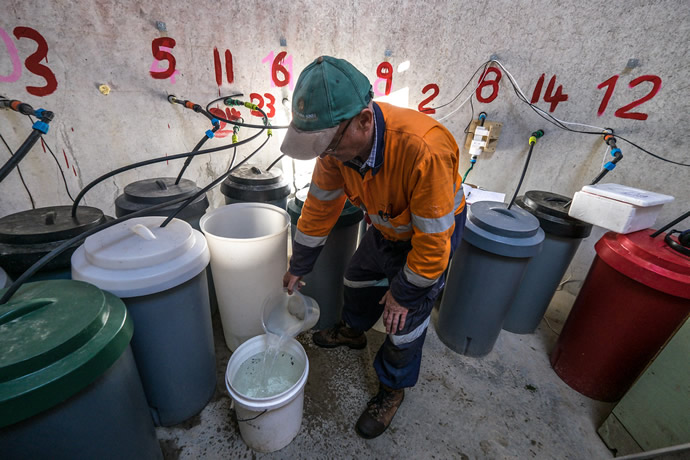Nitrate leaching has been a hot topic for the past decade. Dairy farming in New Zealand has faced ongoing scrutiny for nitrate leaching following conversion of dryland areas on stony soils to intensive dairy farming, irrigating using dairy effluent as well as water to encourage pasture growth.
One alternative management practice, discovered by Manaaki Whenua’s Malcolm McLeod, is for farmers to reduce their nitrogen footprint by converting areas of land to forage crops such as lucerne. Lucerne has deep roots that give access to water lower in the soil profile during dry periods and doesn’t need effluent as fertiliser. However, lucerne grows less vigorously in winter when leaching losses are high, and the effects of irrigation and effluent applications are unknown

Malcolm McLeod measuring the waste collected from the large lysimeter on the farm in Tihoi
In his previous research in the Taupō catchment, McLeod demonstrated nitrogen leaching from cut-and-carry lucerne (where the leafy high-protein forage is harvested and baled into hay or silage) was dramatically reduced to only five kilograms per hectare per year. This was a breakthrough finding and gave farmers an additional landuse option within a highly nutrientconstrained catchment.
This success in Taupō led researchers to examine the effects of lucerne in a stony catchment. Over the past four years our researchers, in collaboration with Lincoln University, Plant & Food Research, Scion and the University of Canterbury, have been testing the benefits of lucerne on two neighbouring paddocks of newly established crops on stony soil at Ashley Dene Research and Development Station, near Lincoln.
Lucerne without effluent for less N and more C They have been using large lysimeters located on two paddocks to measure annual carbon, water and nitrogen inputs and losses. “In the trial, one of the stony paddocks received irrigation and effluent and the other received only rainfall,” says lead scientist David Whitehead.
“Results in the first conversion year in Lincoln showed irrigated lucerne was carbon-neutral despite losses during the conversion process. In the second and third years carbon losses exceeded carbon uptake, resulting in soil carbon losses up to 3% of total soil carbon, and then in the fourth year the irrigated site continued to lose soil carbon while there was a small net gain at the nonirrigated site,” explains Whitehead.
Overall, nitrogen leaching losses occurred at both sites, but they were much greater at the irrigated site. “So we can now say irrigating with effluent is not recommended as a good management practice for lucerne on stony soils,” adds Whitehead. He concludes that the findings highlight the need for alternative cutting or grazing management to avoid carbon losses, at least during the years following crop establishment. The data from the trials will be important for validating farm nutrient balance models and to help farmers identify management practices to realise the benefits of growing lucerne while minimising carbon and nitrogen losses.



